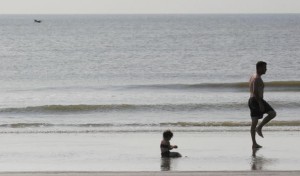Why Dead Fish Are Washing Up on the Beaches of Galveston

Photo by Dave Einsel/Getty Images
A father and daughter play on the beach in Galveston in 2005. A red tide in Galveston Bay is causing dead fish to wash up on shore this week.
Thousands of dead fish are washing up on the beaches of the Upper Texas coast, as the first red tide of the season strikes the Gulf. So this means parts of Galveston Bay are closed off for shellfish harvesting, including Texas Gulf oysters.
A red tide is also known as an algal bloom, and gets its name from how it can color the seas. When algae proliferates in the water, it takes away oxygen and nutrients from fish. “If the algae are there, and there’s no oxygen there, the fish will either move out, or they’ll start to die,” Leslie Hartmann, Matagorda Bay Ecosystem Leader at the Texas Parks and Wildlife Department, explained in an interview with StateImpact Texas a few months back. “And it gets into a vicious cycle whereas fish start to die, they start to decompose which adds to the whole taking out the oxygen from the water.”
Part of the blame could be due to less fresh water coming into the bay from rivers and streams. As the water becomes more salty, algae “blooms,” resulting in a red tide. (Warm temperatures help, too.) Last year’s red tides, greatly exacerbated by the record single-year drought, nearly killed the entire Texas oyster season.
More from the Texas Parks and Wildlife Department:
“The bloom is suspected to have caused fish kills along a number of locations along the upper coast, including Crystal Beach, Galveston, Surfside, Sargent’s and Matagorda beaches. TPWD plans to conduct an overflight of the entire Texas coast before the end of the week to get an aerial view of the bloom’s extent.
Karenia brevis is a naturally-occurring organism that produces a toxin affecting the central nervous system of fish which causes paralysis and the inability to breath. As a result, red tide blooms often result in dead fish washing up on Gulf beaches. When red tide algae reproduce in dense concentrations or “blooms,” they are visible as discolored patches of water, often reddish in color.”
Parks and Wildlife says that if you’re near the red tide, you “may experience irritation of the eyes, nose, and throat, as well as coughing, wheezing, and shortness of breath,” and the symptoms can be worse for those with respiratory illnesses.
Update: KUHF, our local public radio partner in Houston, has more here.

